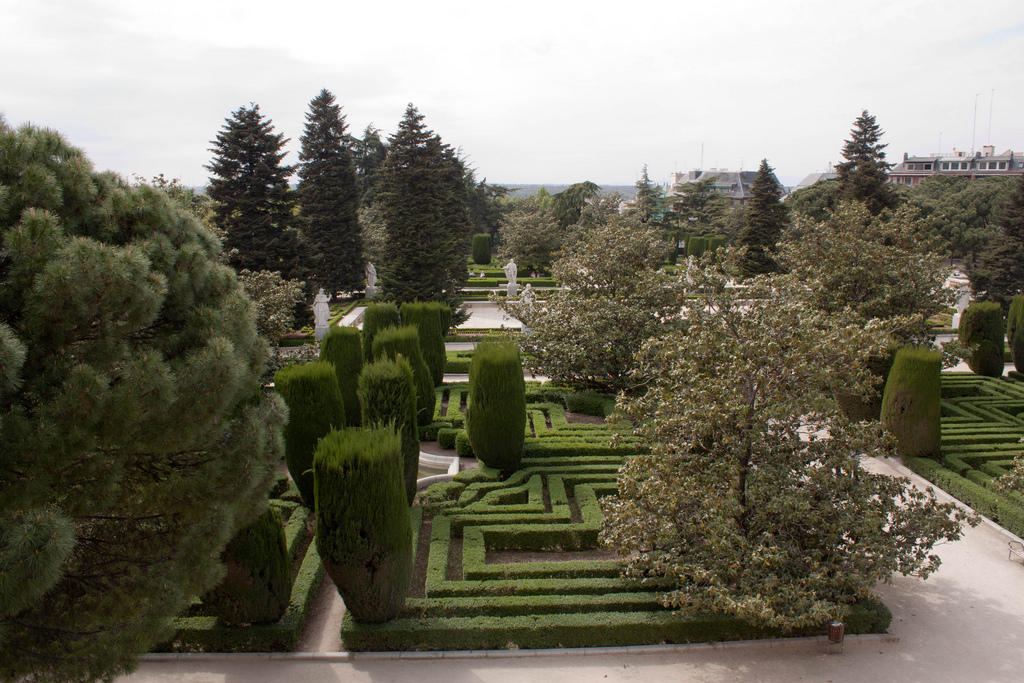- Overview
- El Retiro
- Casa de Campo
- Parque del Oeste
- Real Jardín Botánico
- Campo del Moro
- El Bosque de los Ausentes
- Jardines de Sabatini
- Dehesa de la Villa
- Madrid Water Reservoirs
- Parque Zoológico de Madrid
- Madrid Safari
- Casa de Fieras
When most people hear the words “Madrid and tourism” used together their thoughts likely turn to the hundreds of museums, galleries and historic monuments this bustling Spanish capital has to offer. This is certainly understandable. Madrid is undeniably one of the world’s most culturally and historically significant cities and home to countless collections of artistic masterpieces and some of the most majestic architecture on the planet. However, what many may not realize is that Madrid is also a city that possesses great natural beauty—a beauty reflected in its mountains, rivers, lakes and forests. These natural sites serve as a respite from the fast-paced life of the city and provide countless opportunities for rest and recreation through activities such as hiking, fishing, hunting, boating and skiing.
One of the reasons Madrid is so very popular as a tourist destination is the diversity of sites and attractions it offers, each providing an opportunity for enjoyment, enlightenment or both. This includes many natural sites both within and just outside of Madrid where people can escape the hustle and bustle of the city and recharge their collective batteries.
Unlike most major cities, whose green space and common areas have given way to new construction and are now very limited at best, Madrid boasts one of the most extensive areas of parks, gardens and environmentally-friendly zones of all European cities and world capitals. Taken collectively, these areas make up over 33 million square meters of parkland, distributed evenly throughout the city in the 40+ parks situated within urban limits. This is certainly good news for locals and tourists alike, giving them ample opportunities to stretch out, relax and recreate while enjoying all the color and natural beauty that makes up Madrid’s landscape. To give you a better idea regarding some of the features and natural aspects associated with these “green zones,” below we have compiled a list highlighting some of the more important parks and gardens in Madrid, complete with a brief description of each.
Overview of Popular Parks and Natural Sites in Madrid
Rio Manzanares. The Manzanares River, which flows from the Sierras de Guadarrama, and passes through Madrid on its way to the Jarama River, is the most important waterway in the Spanish capital. Not only does it supply Madrileños with most of their water supply, it affords them an abundance of recreational opportunities, including boating, fishing and water skiing. Its upper basin, a favorite spot of hikers and nature watchers for its untouched beauty, is protected by the government as a Natural Reserve. Not surprisingly, the river was often used as the backdrop for many famous Spanish paintings, including several by Francisco Goya in which children and families are shown picnicking and playing at the water’s edge. It is also considered by historians as the chief reason the area now known as Madrid was initially settled by the Muslims.
Madrid Rio. Also known as Madrid Riverside Park, Madrid Rio is a glorious recreational oasis that stretches for 10 kilometers along the banks of the Manzanares River. The park offers a wide array of sports and leisure facilities, and features plenty of green space and several historical monuments. Children can play at one of the seventeen park playgrounds, or cool off from the summer heat at the Urban Beach, an area formed by three oval-shaped water areas with different effects: a smooth stretch of water, jets of varying heights and a cloud of water vapor. Youth and adults can practice their skills on the tennis and paddle courts, or take place in a game on one of the many football pitches the park has to offer. Joggers and cyclists can be seen regularly along the Salon de Pinos, a gorgeous 6-kilometer tree-lined promenade along the river, and the Aniceto Marinas Gardens, offering a treat to the eyes and nose, is just one of the many green spaces you’ll encounter along the way.
Playa de Madrid. Made possible by a large reservoir that catches the Manzanares River as it passes through the Monte de El Pardo, the Playa de Madrid is a wildly popular locale for summer-fun seekers. The beach, which is located near the Zarzuela Hippodrome just two miles upstream from the San Fernando Bridge, offers something for everyone’s tastes, particularly in the category of water sports. So whether you’re into boating, skiing or just basking in the warm Madrid sun, the Playa de Madrid is definitely the place to be.
Parque del Retiro. Perhaps Madrid’s most popular and oft-visited park, the Parque del Retiro occupies nearly 300 acres (120 hectares) of total land space and is situated in the very heart of the city. This park originated as the gardens and retreat area for the Palace of the Buen Retiro, but in 1868, under a decree by the First Spanish Republic, it was opened to the public and remains so to this day. Abounding with shade trees, colorful shrubbery and grassy expanses, Parque del Retiro offers the perfect respite from the hot summer sun, with a number of unique features and characteristics. The large boating lake, for example, for which guests can rent rowboats for a small fee, provides the perfect backdrop for the outdoor shows and weekend street theaters performed along its banks, and the park’s Rosaleda, or rose garden, offers a splendor that simply has to be seen to fully appreciate. Also present in the Parque del Retiro is the Palacio de Cristal, a stunning glass exhibition hall built in the tradition of the old Crystal Palace in London.
The Casa de Campo. The Casa de Campo, which translates literally to the “Country House,” spans a whopping 1,722 hectares, making it one of the largest parks in Europe. This park traces its roots back to the 16th century, when Felipe II ordered the purchase of the Vargas’s country house. Over the years that followed, many estates and further grounds were added to the property—a property that would later assume the name “Royal Forest” under the reign of Fernando VI. Sadly, much of the Casa de Campo was destroyed during the Civil War, but since being handed over to the City Authorities in 1963 the restoration of the grounds has been nothing short of spectacular. Featuring a flora that includes ash groves, copses and majestic Mediterranean oaks, and a fauna of hundreds of varieties of small mammals and birds, the Casa de Campo is a must-see attraction for visitors touring Madrid. As a bonus, the park also plays host to Madrid’s zoo, an amusement park and impressive trade fair facilities.
-
-
- Campo del Moro & the Sabatini Gardens. Belonging to the Royal Palace, these gardens were open to the public in 1978 under an order by then King Juan Carlos
- Parque de la Fuente del Berro. Perhaps the most interesting feature of this 7.4 hectare park is the 1200 square meters of plant species that are easily recognizable to the blind due to their aroma and feel.
- Botanical Gardens. Situated next to the Museo del Prado, these gardens, which were inaugurated in 1781 by Carlos III, boast over 30,000 species of plants.
-
Other notable parks and green spaces worth checking out while you’re in Madrid include:
-
-
- Parque del Oeste, Madrid’s best landscaped park
- Parque de la Dehesa de la Villa
- Monte de El Pardo
- Parque Enrique Tierno Galvin, a 54 hectare park at which you’ll also find Madrid’s Planetarium and an Imax 3-D cinema.
-
To help you become more familiar with some of these pristine locales, below we have identified several of Madrid’s natural playgrounds and provided an in-depth description of each.
El Retiro
The Parque del Retiro, also known as the Parque del Buen Retiro, is the most popular park in Madrid, and a great place for tourists and locals to mingle and stroll with their families as fortune tellers, street musicians, jugglers and sidewalk painters provide the unique entertainment. The Parque del Buen Retiro is more than your usual park. It has a rich collection of history and Spain’s grandeur.
Parque del Retiro is known to locals as the Royal Park, which was indeed the original function of this well-loved recreation area. It belonged to the Real Sitio del Buen Retiro Palace—a palace constructed by King Philips IV in 1632 as a retreat—or “retiro”—for the Royal family. At that time, the park was situated well beyond the walls of the city, but Madrid has since enclosed the Parque del Retiro entirely. It now consists of roughly 320 breathtaking acres of total land area and has been open to the public since 1868. While parts of the park remain wholly natural and untouched, others are laid out in a French colonial style that was popular during that era.
Although most of the original buildings that dotted the landscape of the Parque del Retiro were destroyed during the Napoleonic Wars, two of them still remain: the Museo del Ejército and the Casón del Buen Retiro. The Museo del Ejército is a military museum that houses several interesting pieces associated with Spain’s military history, including a majestic collection of armor and a must-see sword believed to have been used by El Cid or La Tizona. This museum is also home to the cross worn by Christopher Columbus on his sail to the New World. The second remaining building, Casón del Buen Retiro, is also a museum, housing 19th and 20th century paintings, including several works by Joaquín Sorolla. In 1868, the park was officially opened to the general public.
Buen Retiro Park is open year-round from 10:00 AM until at least 6:00 PM (it is open until 9:00 PM during the summer) and admission is free for children and adults.
Retiro’s Pond (Estanque del Retiro)
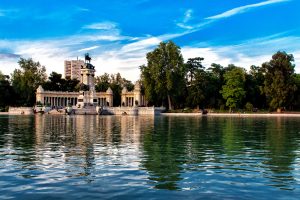
El Estanque, or as it is sometimes referred to, “the Lago de Retiro,” is a very attractive man-made lake located in the center of the popular El Retiro Park. The park and the lake are open year round for the enjoyment and relaxation of their guests, but in the late spring and summer months, under the blaze of the warm Mediterranean sunshine, El Estanque becomes an especially alluring draw that most people find hard to resist. During this time, everyone visiting the park seems to navigate automatically to this area, from the locals and tourists to the mime performers and vendors, selling souvenirs, tasty snacks and cool refreshing drinks. Rowboats and canoes are available for rent, and on any given day you’ll find scores of people dotting the lake and enjoying the spray of its cool clean water.
The focal point of El Estanque is the massive memorial dedicated to King Alfonso XII. Inaugurated in 1922, the monument is 30 meters high at its apex and a whopping 86 meters in length. It features a large colonnade in the rear, decorated in the Baroque style of the period. At its front is a brilliantly detailed statue depicting King Alfonso XII on horseback, created in bronze by the artist Mariano Benlliure. At the base of the monument are four carved lions that seem to guard the statue, sculpted by some of the most famous artists of the day, and on each side of the monument there are two more sculpted lions with cupids, the splendid work of the Spanish artists Escudero, Bofill, Arnau and Campmany.
Visitors of El Retiro Park can often be found sitting or sunning themselves on the large series of steps that connect the King Alfonso II monument to El Estanque; steps that lead down to the lake from the front and on each side of the statue. Others visitors are content to walk along its banks and gaze at the many varieties of fish that inhabit it.
In addition to the several kiosks that are set up along El Estanque’s banks, selling ice cream and other cool treats, there is also an outdoor restaurant offering traditional Spanish fare and other mouthwatering favorites. This is a wonderful place to have lunch and refuel before returning to your busy tour schedule.
Monument of Alfonso XII
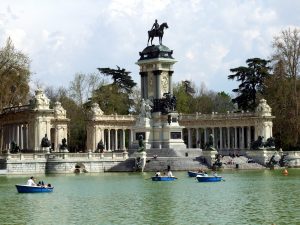
Overlooking the Estanque del Retirois the monument of King Alfonso XII. It was constructed in 1922 through the king’s mother initiative. The monument features a semicircular colonnade with an equestrian statue of the monarch at the center.
In 1902, on the initiative of the queen mother, Dona Maria Cristina of Hapsburg-Lorraine, it was decided that a monument would be erected to commemorate her son, King Alfonso XII, and a competition was held for the right to design and build it. Ultimately, the project was awarded to Jose Grases Riera. The architect chose mostly bronze and marble for the new structure, and oversaw the construction of the landmark along the long side of the pond. The design included a grand colonnade with numerous sculptures, the work of over 20 local artists who collaborated with Grases on the project.
The monument was formally inaugurated on June 6, 1922. The entire assembly is 30 meters in height, 86 meters in length and 58 meters wide. It was the first commemorative statue built in the park during the 20th century. It depicts King Alonso XII on horseback, cast in bronze and created by the artist Mariano Benlliure. Stairs lead down from the monument to the pond, and at the base of the monument are four carved lions, each sitting atop artistic pedestals created by the artists Parera, Atché, Coll and Alsina. There are also two lions with cupids on each side of the monument, the collaborative work of the artists Francisco Lozano Escudero, Bofill, Arnau and Campmany.
The inside of the Monumento a Alfonso XII is also splendidly decorated with many friezes and sculptures. The monument is solemn and well-protected, as it also serves as a mausoleum, where the remains of King Alfonso XII are interred. Although certainly not the oldest landmark in the city, the Monumento a Alfonso XII is one of the most remarkable examples of 20th century Spanish architecture and art, and a must-see attraction when visiting Madrid and the famed Buen Retiro Park.
La Rosaleda
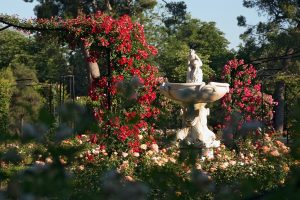
The Rosaleda, or rose garden, in the Parque del Retiro, is a treat for the eyes and nose, with beautiful roses of all colors gracing the landscape.
La Rosaleda was designed in 1915 by Cecilio Rodriguez, the head gardener for the city of Madrid, at the request of the Mayor, Carlos Prats. It was modeled after the rose garden in the Bois de Boulogne in Paris, France, and was designed to serve as a type of centerpiece for the various palaces and monuments that grace the park. After the garden was completed, it initially included a statue at its main entrance depicting the Marquis of Salamanca, but during the Spanish Civil War in the late 1930s, that statue disappeared and the garden itself sustained damage.
Strolling through La Rosaleda offers a treat for the eyes and nose, particularly during the spring and early summer months when the roses are in full bloom. Many different Spanish rose varieties are on display at the garden, featuring almost every color in the rainbow. The most important rose breeders in the world are represented at La Rosaleda; breeders who use the garden as a test plot to study the behavior of certain species of roses in the Madrid latitude and climate.
The layout and ultimate success of La Rosaleda is attributed almost entirely to gardener, Cecilio Rodriguez. Today, the gardens bear his name in honor of his contributions. Important to note is that in the 1930s and 1940s, the work of Rodriguez continued and ultimately resulted in the creation of many other rose gardens throughout the city.
Near this area is perhaps one of the most interesting and unique features of the park, a statue named El Angel Caido. The statue is dedicated to Satan and is quite possibly the only such statue in Europe.
Jardines de Cecilio Rodríguez
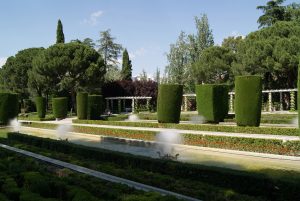
The Jardines de Cecilio Rodriguez is one of the largest, most beautiful and well cared for gardens in all of Spain, designed by, and later named for, Cecilio Rodriguez.
Born in 1865 in the town of Valladolid, Cecilio Rodriguez became a gardening apprentice in the city of Madrid when he was just a young boy. Over the years he perfected his gardening skills, and in 1914 he was commissioned to create the Rosaleda del Retiro, a beautiful Rose Garden that still remains today, also located in Buen Retiro Park. Following his success with the Rose Garden, he was named the Director of Parks and Gardens for the City of Madrid, a position he held until he retired. During his time as Director he worked on, and some say perfected, a garden then known as the Herrero Palacios Gardens, which the city renamed the Jardines de Cecilio Rodriguez in honor of all his hard work and dedication to the parks and gardens of Madrid.
The Jardines de Cecilio Rodriguez is one of the most popular attractions in Buen Retiro Park, an oasis located just yards away from one of the busiest world capitals in all of Europe. The gardens are a mixture of tall trees, beautifully landscaped shrubs and walkways, and thousands of colorful plants and flowers. Walking through the gates into the Jardines de Cecilio Rodriguez is like walking into a park within a park, highlighted by stone pine trees, trimmed cypresses, pergolas, and strolling peacocks. The garden features four ponds, all with sparkling fountains in the center, one in the shape of a seagull, sculpted in iron by Malaga Jaime Fernandez Pimentel. It was donated by the country of Norway to Madrid in 1962, and is surrounded by eight large columns of granite.
The Jardines de Cecilio Rodriguez is a must-see attraction when visiting Madrid, one you’ll remember years afterward for its simple and colorful beauty. It is located very close to the Puerta de Alcala and not far from the famous Prado Museum. Luckily, the Madrid Metro has a stop right in front of the park’s gate.
El Retiro: Other Points of Interest
Crystal Palace (Palacio de Cristal)
Towards the southern end of the park you will notice a gorgeous glass building. This is the Palacio de Cristal, built in 1887 by Ricardo Velasquez Bosco after the Crystal Palace in London. It is made of glass and steel. The beautiful building was initially used to house exotic plants brought from the Philippines, but is now used almost exclusively for temporary exhibits.
The expansive areas of grass, trees, lakes and flowers lend a sense of splendor and serenity to the Parque del Retiro, a Madrid attraction whose historical significance is overshadowed only by its beauty.
Forest of the Departed (Bosque de los Ausentes)
It is a memorial shrine to commemorate the 191 victims of the Madrid train bombings in March of 2004 and the special force agent who died after a bomb attack in April 2004. The monument has 192 olive trees symbolizing each victim and is surrounded by a channeled stream current.
Fountain of the Fallen Angel (El Angel Caido)
Designed and carved by Ricardo Bellver, it is a symbolism of Lucifer falling from heaven. The Fountain of the Fallen Angel was built in 1874 through the initiatives of Duke Fernán Núñez. It is believed to be the only statue in Europe dedicated for such purpose.
Palacio de Velázquez
The Palacio de Velázquez was originally built for the Mining Exhibition of 1833. It is named after its architect Velázquez Bosco. The exterior is presented with 2-toned brickwork and tiles surrounding a metal edge crowned by a dome.
Madrid Book Fair (Feria del Libro)
For bookworms, the Madrid Book Fair is your place to be. It is held for 3 weeks starting on the last weekend of May. It is an open-air affair generally made up of at least 350 stalls. There is no reason for you not find something interesting with a vast collection of books available in this event.
Performances and shows
The Banda Sinfónica de Madrid provides free concerts every Sunday beginning late May until early October. There are various entertainments during the weekends such as street theatre actors, jugglers, fortune tellers, painters, musicians and more.
Casa de Campo

Casa de Campo encompasses over 1,722 hectares (4,255 acres) of total land area, on which can be found a wide range of facilities, hundreds of plant and animal species and plenty of historical remains from years gone by. These features make the park a perfect getaway for lovers of nature, history and Spanish culture, as well as recreational enthusiasts.
The history of the park dates back several centuries, when in 1553 King Felipe II decided to move the Royal Court to Madrid and ordered the purchase of the Vargas family’s country home. Over time, the park continued to expand with the addition of adjoining properties, and during the reign of Fernando VI it was declared a Royal Forest. This was primarily due to the park’s proximity to the Royal Palace and the purpose the park played as a hunting site. When King Carlos III took the throne in the mid 1700s, Casa de Campo underwent reforms and the park was transformed into a livestock and farming area, activities continued during the reign of Queen Maria Cristina.
With the dawn of the Second Republic in Spain, ownership of the Casa de Campo was transferred to the city and the park was finally opened to the public for their enjoyment. Activities in the park were put on hold, however, during the three-year Spanish Civil War, as the site became one of the many stages of battles and bombings. To the delight of all Madrilènos, the park was reopened for good in 1946. Since then, reforestation efforts and the development of recreational and cultural facilities have made the park one of the city’s most treasured attractions.
Casa de Campo has been home to many historical structures throughout its history. Many of those have since been destroyed by weather, fire, time and war, but a few well-preserved buildings continue to stand proudly to this day. These include the majestic Palacio de Vargas and the Puente de la Culebra (Snake Bridge), built by Sabatini in 1782 on the Arroyo de Meaques, a tributary to Madrid’s main river and water source, the Rio Manzanares.
Other historical remains in the Casa de Campo include the mid-19th century Railway Bridge; La Tapia, built by Sabatini to transport water; La Partida, a site for experimenting with medicinal plants; the Reservado, gardens that surround the Palacio de los Vargas; the historical fountains; and several trenches and bunkers from the Spanish Civil War.
Casa de Campo’s rich vegetation and animal life is what makes this park such a great place to visit. Oak trees, many of which are well over 100 years old, are the dominant species in the park, but the pine-forest ecosystem also now boasts a large number of trees that have adapted flawlessly to the light, dry conditions of the park. In addition to the plant life, there are over 133 species of animals in the park. Birds outnumber all other animals, especially sparrows, but also finches, blue-throats and owls. Rabbits, squirrels and even a hedgehog or two can also be seen regularly, as can reptiles such as geckos, Montpellier snakes and Iberian lizards.
As for things to do and see in the park, the Parque de Atracciones, or amusement park, is a great way to spend the day, and the National Zoo, which features over 500 species of animals, is perfect for the animal lovers in the family. Visitors to the park can also participate in a wide range of land and water sports, including jogging, cycling, tennis, swimming and canoeing, and can later cool off at one of the many restaurants or cultural facilities located on the grounds.
El Parque de Atracciones

With over 48 rides and attractions, the Parque de Atracciones of the Casa de Campo is one of the most comprehensive urban fairgrounds, not only in Spain, but in all of Europe. Each year, millions of locals and tourists walk through the gates of this expertly designed park, all seeking to shake the stress and/or boredom of their workaday lives in favor of some fun-filled family excitement. Whether you come for the heart-stopping roller coasters, the refreshing splash of the man-made Rapids or just a leisurely walk through nature, the Parque de Atracciones has everything you and your family need for a full day of adventure and relaxation.
The rides, shows and many restaurants that make up the Parque de Atracciones are divided into five large themed areas: Maquinismo (Machines), Gran Avenida (Main Avenue), Naturaleza (Nature Area), Tranquilidad (Relax), and Infantil (Kid’s Area). Below is just a brief description of what you’ll find at each:
Maquinismo
If you enjoy the fun and excitement of roller coasters and other thrill rides, the Maquinismo, or Machines area of the Parque de Atracciones is definitely the place to be. The most popular area of the park for the young and young at heart, this area boasts 12 fast-paced rides, including the Top Spin, a platform that performs circular vertical movements, swings and loops; and La Lanzadera (The Shuttle), a free fall ride from 63 meters at approximately 80 kilometers per hour. You may also want to try out the ride called Maquina, or Machine, but we recommend you do so before lunch. This giant pendulum with a double simultaneous rotation provides an amazing adrenal rush, although it is not always suited for sensitive stomachs.
Gran Avenida, Naturaleza and Tranquilidad
When you’re ready to take a break from the high-flying excitement of the Machines area, try taking a stroll down the Gran Avenida, the Main Street area in which you’ll find most of the park’s snack shops and restaurants. If you’d rather bring your own lunch or supper, this area also features plenty of tables and green space to spread out and have a picnic, while watching the squirrels jump from tree to tree to the sound of ducks quacking in the nearby zoo.
The Nature area, which offers shaded walkways through the natural flora of the park, is not far from the Gran Avenida. This favorite spot of summertime patrons is the perfect place for cooling off from the hot Madrid sun. It is also home to the attraction known as Los Fiordos (The Fiords), a wooden barge ride that floats upon a 56-meter high precipice—a ride that is guaranteed to leave you with wet socks and a fun memory.
Tranquilidad is the perfect area of the park for winding down after a full day of non-stop thrills; an area offering several family attractions geared towards restoring your normal levels of adrenaline. Here you can enjoy peaceful rides by boat and hot air balloon, travel through different world cities, walk among the dinosaurs and enjoy a short but stunning 4-Dimensional movie on a mammoth-size screen. If you dare, you can also make your way to the El Viejo Caseron (Old Manor) attraction when visiting Tranquilidad, a walk through a sinister old house where you’ll encounter some of the scariest and most notorious characters of the film world, including Hannibal Lecter, Freddy Krueger and the girl from the Exorcist.
Infantil
And finally there is the Infantil area of the Parque de Atracciones, a must-top when touring the park with very young children. This region of the park consists of age-appropriate miniature facilities designed for children 3-7 years of age. Here you’ll find 16 mini-rides, including a shuttle, rollercoaster and water ride, as well as puppets, slides, fairy tale characters and a variety animals dressed in costume that are more than happy to pose for pictures.
Parque del Oeste
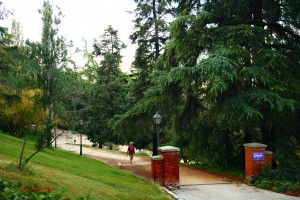
Are you traveling to Madrid, Spain in the near future and need some ideas with regard to what to do and see while visiting this historic and very picturesque city? Do you enjoy visiting “green” attractions, such as parks, lakes and gardens, attractions for which the city of Madrid is rapidly becoming very well-known? While most outsiders would tend not to associate natural beauty with a busy world capital such as Madrid, upon visiting, many of them would realize the city is actually one of the greenest of its kind in the world, with acres upon acres of lush parks and garden space situated in and around the city limits, including the Parque del Oeste.
In total, there are over 40 urban parks in Madrid, the most renowned and remarkable being the Parque del Buen Retiro (Buen Retiro Park), located just east of the historic downtown district. Although not quite as popular, the Parque del Oeste (“Park of the West” or “Western Park”) is equally impressive. It is located, as its name implies, on the western side of this same district, just to the north of the Palacio Real, or Royal Palace. The park stretches north along the street known as the Paseo del Pintor Rosales, and continues north towards the Moncloa district of Madrid.
Fuente Juan de Villanueva, Parque Oeste photo creditParque del Oeste was initially conceived in the 1890s by Celedonio Rodrigañez y Vallejo, who at the time was in charge of Madrid’s gardens and parks. Landscape architect Cecilio Rodriguez, who would later ascend to the position of Park’s director, was put in charge of the project, and converted the area—a former rubbish dump site—into a large English styled garden. The park officially opened to the public in 1905, but had to be recreated in the early 1940s after the park was damaged during the Spanish Civil War of the late 1930s.
There are a number of sights and attractions that make visiting the Parque del Oeste an absolute treat for tourists and locals alike. Some of these include:
Rosaleda de Parque del Oeste. Created by landscape designer Ramon Ortiz in 1958, the Rosaleda, or Rose Garden, in the Parque del Oeste is best known for its annual flower show and competition.
Templo de Debod
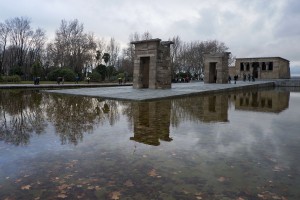
The History behind Templo de Debod
For centuries, the Templo de Debod stood proudly in the Nile Valley of Egypt, approximately 19 miles from the city Aswan. The temple was constructed in the 4th century BC to honor the god Amun and the goddess Isis. However, when the construction of the new Aswan Dam commenced in the mid 1960s, it threatened the future of the Templo de Debod. Fearing they would lose it, the Egyptian government offered the temple to Spain in gratitude for its help in saving some of the sacred buildings in the town of Abu Simbel, Egypt some years prior. Spain accepted the gesture, and in 1969 the temple was carefully dismantled and its pieces were sent by ship to the Spanish city, Valencia, where it was then shipped by train to Madrid. There it would be meticulously reassembled at its current site, finally opening to the public in 1971.
The Temple de Debod is just one of many ancient monuments and archaeological treasures that were displaced by the Aswan Dam, but with help from the United Nation’s (UNESCO), all found new homes in other major cities where they could be preserved and put on display for tourists and historians.
Characteristics of Temple de Debod
Today the Temple de Debod is showcased near the Plaza de España, next to the Paseo del Pintor Rosales, with a surrounding park from where it is possible to admire the Guadarrama mountains and the Spanish capital’s most breathtaking sunset. The temple is laid out from East to West, just as it would be in Egypt according to their tradition. Further below the monument is an attractive rose garden, the Rosaleda, with several beautiful and colorful varieties of roses.
Tourists who want a closer look at the temple may make their way through the two tall, narrow gateways that lead the way to the temple’s colonnaded porch, and admire some of Temple de Debod’s detailed carved reliefs. In the temple’s upstairs there is a terrific museum to explore, featuring photographs depicting the monument’s history.
From the tour guides on site, visitors will also learn that the location chosen for the Temple de Debod is also very historically significant, as it was once the site of the Montaña barracks, which were stormed by the populace during the Civil War in 1936.
Cementerio de la Florida. On May 3, 1808, during the French occupation, French troops executed 43 Spanish rebels near the Parque de la Montaña, an event famously depicted by the Spanish painter Francisco de Goya. The casualties from that fateful day lie buried at the Cementerio de la Florida, a small cemetery located just northwest of the Rosaleda.
In addition to the sights and attractions listed above, the Parque del Oeste is also home to the Fuente de Juan de Villanueva, one of the city’s tallest fountains created in 1952 by sculptor Santiago Costa and a trio of architects; and the Monumento a Goya, a modern monument honoring Spanish artist Francisco de Goya, located in the western portion of the park.
Many people traveling through Madrid are surprised to learn that there is a genuine/authentic Egyptian temple in the middle of the city, not far from the Plaza de España. The Templo de Debod, which dates back to the 4th century BC or earlier, has graced the city of Madrid since 1971 and, according to historians, it was originally built to honor the Egyptian gods Amun and Isis. The real question, though, is how did it get there?
Real Jardín Botánico
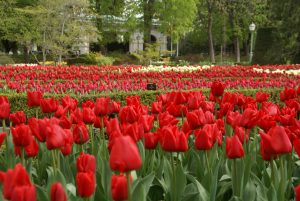
The Real Jardín Botánico, or in English, the Royal Botanical Garden, is a 20-acre (8-hectare) botanical garden in Madrid, situated at the Plaza de Murillo, next to the Museo de Prado (Prado Museum).
The history of Real Jardín Botánico can be traced back to October 17, 1755, when the garden was founded by King Ferdinand VI and installed in the Orchard of Migas Calientes, near what is now called Puerta de Hierro, on the banks of the Manzanares River. At that time, Real Jardín Botánico contained approximately 2,000 plants, all collected by the botanist and plant surgeon Jose Quer y Martinez. The garden would remain at this location for approximately 19 years, but in 1774 King Charles III ordered that it be moved to its current location on the Paseo del Prado.
The new garden was designed by the architects Francisco Sabatini and Juan de Villanueva, who together organized the garden into three tiered terraces, arranging the plants according to the method of Linnaeus. The new site opened in 1781, not merely as a place to showcase the plants, but also as a locale at which to teach botany, promote expeditions for the discovery of new plant species and classify them. The herbarium housed at the Real Jardín Botánico, which was part of the new design, is now the largest in Spain, with over 1 million species.
In 1794, the collection of plants at the Real Jardín Botánico was augmented by a collection of 10,000 plants brought to Spain by Alessandro Malaspina. The War of Independence in 1808 caused the garden to be abandoned for a time, but in 1857 it was revived under the new director of the site, Mariano de la Paz Graells y de la Aguera. With his leadership, the garden added a greenhouse and renovated the upper terrace among other improvements. He even added a zoo at the site, but this was later moved to Retiro Park. In the decade of the 1880s the garden suffered heavy losses, including losing nearly 5 acres to the Ministry Of Agriculture in 1882, and damage from an 1886 cyclone that wiped out over 550 trees. Since 1939 the garden has been dependent on the Spanish National Research Council for funding, and in 1942 it was declared an Artistic Garden by the State. The park was ultimately closed in 1974 due to years of neglect and hardship, but it reopened in 1981 under new leadership.
Today the Real Jardín Botánico is a very popular destination for tourists and locals alike, and its proximity to the Prado Museum, one of Spain’s premiere attractions, guarantees plenty of visitors each year. The garden is characterized by a series of neatly laid out and well-cared-for beds of flowers, plants, medicinal plants and herbs. Particularly attractive are the native roses, with a variety of hues and varieties, and the Classical Romantic Garden, which features a beautiful duck pond. Trees and shrubs are also abundant and account for the remainder of the site’s flora. In total there are now an estimated 30,000 plants and flowers at Real Jardín Botánico and over 1,500 trees.
Campo del Moro

The Campo del Moro, which translates to the “Field of Moors,” is located along the eastern bank of the Rio de Manzanares, a river that cuts through Madrid and a primary source of the city’s water supply. Interestingly, the park is very near the Sabatini Gardens, which together with the Campo del Moro and a few other sites, makes up a system of parks and gardens adjacent to the Palacio Real, or Royal Palace. Campo del Moro is situated directly behind this impressive palace, facing south, while the Sabatini Gardens can be found in front of the structure.
The site that is now home to the Campo del Moro is perhaps as historically significant as the park itself. Throughout the 12th century, while plotting to recapture Madrid from the Christians, the Muslim leader Ali Ben Yusuf and his battalion of Moor soldiers camped at this very site. This, according to historians, is how the park ultimately got its name: the Field of Moors.
During the reign of Felipe IV and after the old palace burned down, the King ordered the construction of the Campo del Moro in conjunction with the construction of the new palace. Funds were tight during this era, however, and the park and gardens were routinely neglected. This would change during the reign of Queen Isabella II, as she vowed to create a garden worthy of the palace’s Royal standing. This promise led to a total renovation of the site, including the addition of several spectacular fountains. Two of these fountains—the Fountain of Tritons and of the Shells; and the Triada of the Palace of Aranjuez—are especially striking, and together they serve as the central highlight of the park.
Towards the end of the 19th century, under the Regency of Maria Cristina, many elements that reflect the romanticism movement of the era were added to the park. Open spaces, for example, were created for new trees, and curved alleyways, made in the English style, were created, but even after these 19th century additions, the two fountains remained—and continue to remain—in the park’s center, serving as an axis off of which the other elements in the park feed.
Tourists who visit the Campo del Moro can participate in a number of recreational activities—jogging, cycling, etc.—or merely sit and enjoy the natural flora, with a countless number of plant and tree varieties. The park is also home to many species of birds and small mammals, particularly rabbits and squirrels that playfully romp through the trees and open areas.
As you approach the Campo del Moro for your visit, you will undoubtedly notice the age-old, yet well-constructed steel gate that surrounds the park and the palace grounds, as well as the large iron doorway that serves as the park entrance. Millions of guests have passed through this gate over the years, many of whom describe the experience as taking a step back in time to a much simpler and peaceful era.
El Bosque de los Ausentes
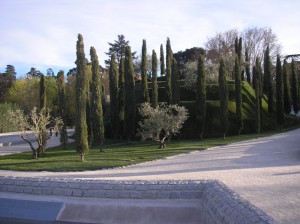
The city of Madrid, Spain, like most major world capitals, has seen its share of tragedy, the most recent example being the Madrid train bombings, carried out on March 11, 2004. However, if the goal of those who committed these senseless and cowardly attacks was to strike fear and somehow discourage the Spanish people, it can only be said that their efforts failed miserably, as evidenced by the manner in which the Madrid community responded and coped with the tragedy in the days, months and years following the attacks. One such coping measure, taken exactly one year subsequent to the attacks, was the inauguration of El Bosque de los Ausentes, or the Forest of the Departed—a garden created in Buen Retiro Park to honor those who lost their life on that fateful day.
The Bombings
The Madrid train bombings, also known in Spain as 11-M, consisted of a series of coordinated and nearly simultaneous bomb attacks against the Spanish commuter train, Cercanias. The attacks, which occurred on March 11, 2004, just three days prior to Spain’s general election, killed 191 people and wounded another 1800. Investigations into these attacks determined that the 7 perpetrators were linked to an al-Qaeda-inspired terrorist cell, although no direct al-Qaeda participation has ever been established. Spanish authorities tracked down the 7 bombers to a block of apartments in Madrid, and on April 3, 2004, with the area under siege, they all committed suicide, their final act of cowardice.
El Bosque de los Ausentes
El Bosque de los Ausentes is a memorial garden located in the Parque del Buen Retiro, familiarly known as Retiro Park. The garden was created to commemorate the 191 civilian victims of the 2004 Madrid train bombings and the special forces agent who perished in the attacks on that now unforgettable date in Spanish history.
If you’re planning to visit Madrid and the beautiful Retiro Park, you will notice that El Bosque de los Ausentes (Forest of Departed) now has a new name: El Bosque del Recuerdo, or Forest of Remembrance. This change was requested by the survivors of the attacks and the victims’ families, arguing that those who died on that horrible day are forever present and have not departed from their hearts.
Today, El Bosque del Recuerdo comprises 192 olive trees and cypresses (one for each person killed), and is surrounded by a channel of water meant to symbolize life. Its location is a large hillock near the Atocha railway, one of the sites of the unthinkable atrocities.
The formal dedication/inauguration of El Bosque de los Ausentes came on March 11, 2005 and was presided over by King Carlos I and Queen Sofia. They were the first to place flowers at the new site, a bouquet of white flowers with a ribbon that read, “In memory of all the victims of terrorism.”
There were a number of important dignitaries on hand for the inauguration of El Bosque de los Ausentes, including the Spanish president, Jose Luis Rodriguez Zapatero, and several world leaders, including UN Secretary-General, Kofi Annan; Afghan president, Hamid Karzai; the King of Morocco, Mohammed VI; and the Prime Minister of Poland, Marek Belka, among many others. At the request of the victim’s families, no speeches were read during the ceremony. All that was heard was the sweet and solemn music of a 17-year-old cellist playing Song of the Birds by Pau Casals.
Jardines de Sabatini

The Sabatini Gardens, known to locals as the Jardines de Sabatini, are part of the grounds of Madrid’s Palacio Real, or Royal Palace. The gardens, which were opened in 1978 by King Juan Carlos I, were created to honor the name and memory of Francesco Sabatini (1722-1797), an Italian architect of the 18th century who designed the palace’s Royal Stables, previously located on the palace grounds, an area now occupied by the gardens.
The Royal Stables were built at roughly the same time the Royal Palace was constructed. They occupied the lower tier of where the Sabatini Gardens are now situated, and provided direct access to the rolling hills west of the Palace, an area in which many of the Royals would use to hunt, often on horseback. During the Franco dictatorship, and the political drive to cleanse the country of many of the Spanish monarch’s possessions, the stables were demolished and, in the words of Franco, “given back to the people.”
Construction of the Sabatini Gardens began in 1933, but a lack of funding and many other interruptions, including the Spanish Civil War of the late 1930s, stalled the progress of construction for many years. The original designer of the gardens was Fernando Mercandal, an architect who was awarded the project after winning a competition against a number of other bidders and designs. Many historians believe this “populous” selection process was Franco’s idea of vindicating himself from the absolute destruction he inflicted upon Madrid during the power struggle for Spain’s leadership.
The Sabatini Gardens were finally opened and inaugurated in 1978. They feature a formal neoclassical design style, consisting of well-kept hedges and pine and cypress trees, many sheared into symmetric geometrical shapes and patterns. The gardens surround a large pool and several fountains, and are adorned with a number of statues, depicting Spanish Kings of the past. These statues have very little detail, as they were never intended to be seen up close. Originally they were intended for the roof of the Royal Palace, but they were deemed too heavy by the architect, and thus sat in storage for decades until they were finally placed in the garden.
The Sabatini Gardens offer a welcome bit of shade and tranquility to the grounds of the Royal Palace, a place where summertime visitors can cool off from the hot Madrid sun. The quiet secluded atmosphere is in part due to the lowered elevation of the gardens, as they sit nearly 10 meters below the busy Plaza de Orient above. They are connected to the Plaza by a grand stone staircase, and because they are set into a side of a hill they provide a perfect and quite majestic view of the Royal Palace.
Sabatini Gardens are open every day of the year, from 7:00 am to 10:00 pm in the winter, and from 7:00 am to midnight during the summer. If taking the Madrid Metro, the most convenient stop is the Principe Pio off Line R of the subway.
Dehesa de la Villa
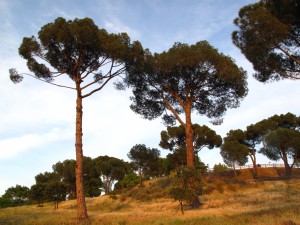
When you consider all of the historical architecture, gorgeous monuments and fascinating museums located in Madrid, it might be surprising to learn that the city is also one of the greenest capitals in the world, home to over 40 lush urban parks, including the Dehesa de la Villa. Whether your goal is sport, recreation or merely relaxation, this park offers everything you need, and with such a convenient location next to the university it has never been easier to escape from the hustle and bustle of the busy inner city.
Dehesa de la Villa is not as well known as some other parks in and around Madrid, such as Buen Retiro Park, but the area is just as charming, if not more. It has a long and distinguished history, and features lazy winding roads that seem to invite you to take a stroll beneath the cover of majestic oak trees.
Dehesa de la Villa Park was once a royal road that connected the Buen Retiro Palace in Retiro Park with the palace in El Pardo. Today this massive and brilliantly landscaped park boasts several play areas for children and plenty of benches on which to sit and watch the world pass by. Perhaps this is why Dehesa de la Villa is so popular among locals year-round. The cerro de los loco, or “mad people hill,” is a must-see when visiting the park. The highest hill in the park, it offers a spectacular view of Madrid, Monte de El Pardo, or El Pardo Mountain, and the Casa de Campo Park.
A trip to Dehesa de la Villa Park is ideal during the warm spring and summer months, a time when park-goers can laze under majestic pines and escape the blistering heat of downtown Madrid. Autumn and Winter, too, offer a number of park pleasures, such as collecting edible mushrooms, or sipping a hot drink on the park’s terrace. Throughout the year, people can be seen jogging and cycling; people who choose Mother Nature as their fitness backdrop, as opposed to a crowded, busy gymnasium. And if it snows? That’s even better. Although not common, the occasional snowfall during the winter months makes for great photo opportunities.
There is a wide variety of flora that adorns the Dehesa de la Villa. Aside from the oaks and pines, you’ll find ash trees, black poplars, cypresses, mimosas and acacias. Birds, including sparrows, blackbirds and goldfinches are the most prevalent form of animal life in the park, but you’ll also see many species of small mammals, particularly rabbits and squirrels. The best part of all this experience is the knowledge that all of this beauty and majesty is just a stone’s throw from Francos Rodriguez Street and the bustling world of civilization.
Dehesa de la Villa is very easy to access. If using the Metro, the nearest stops are Francos Rodriguez and Valdezarza, and if traveling by bus, take route 64, which will drop you right at the park’s entrance.
Madrid Water Reservoirs
Like most major metropolitan areas, Madrid, the capital and largest city in Spain, has a number of dams and reservoirs designed to harness the flow of various rivers that flow in and around the region. These structures help to stockpile water for various purposes throughout the city, including hydrology-based energy and drinking water.
Embalse de Valmayor
In the mid 1970s, the growing water needs of the province of Madrid led to various studies designed to harness the flow of the Guadarrama River through the construction of a large reservoir on its track. Ultimately the decision was made to build the reservoir on the Aulencia River instead, a tributary of the Guadarrama, largely due to the favorable geographical conditions of its valley and the virtual absence of any population in this area. The dam was completed and inaugurated with a grand opening in 1976.
The Embalse de Valmayor, or Valmayor Reservoir, is situated to the northwest of Madrid in the municipality of Valdemorillo. It is managed by the Canal de Isabel II, and belongs to the basin of the Guadarrama River. The reservoir, which runs along a length of eight miles upstream of the Aulencia, occupies an area of 755 hectares and also serves the towns of El Escorial and Colmenarejo. In terms of the amount of water stored, the Embalse de Valmayor is the second largest reservoir in the province of Madrid, with a capacity of 124.4 million cubic meters. The largest, which we will describe in more detail in the next section, is the Atazar Reservoir, located in the basin of the Lozoya River and boasting a whopping capacity of 425.3 million cubic meters.
Despite being built on the Aulencia River, Embalse de Valmayor receives its largest contribution of water from the Guadarrama, located several kilometers away and possessing a much higher rate of the flow of than the Aulencia. Water from the Guadarrama reaches the reservoir through a transfer tunnel, about five miles long, which has a small reservoir sensor called Las Nieves, located near La Navata, a residential area near the city of Galapagar.
Embalse del Atazar

El Atazar Dam is an arch dam situated very near Madrid on the Lozoya River, exceedingly close to where the river joins the Jarama River. It is the oldest dome-style dam in the world and is responsible for creating the largest reservoir in the Madrid area. Given the narrow canyon in which it is built, the arched design of El Atazar makes it optimal for retaining water in the reservoir. Arch dams are thin and require less material to construct than any other types of dams.
Construction on El Atazar commenced in 1968 and continued for four years until it was finally completed in 1972. Prior to building the dam, officials of the Community of Madrid made the decision to use the dam solely for the purposes of storing and regulating water and not for providing energy, a role played by several other dams in the region.
El Atazar’s design features a double curvature, concrete arch buttress. At its apex, it has a height of 440 feet (134 meters) and a width of roughly 172 feet (52 meters) at the foundation. As mentioned above, the reservoir formed by the dam has a total capacity of 425.3 cubic meters, or 344,000 acre feet.
Over its short history, El Atazar has played a vital role in the storing and regulating of water for the Community of Madrid, but there have been some problems and issues with the dam that are certainly worthy of note. In the mid-seventies, monitoring of the dam revealed irregular movement. While most dams tend to move slightly, the left side of El Atazar was found to be moving more than the right, largely due to a support built on the dam’s right side that made the sides less flexible. A small crack was noticed in the dam in 1977—a crack that by 1979 had grown to 150 feet (46 meters) and had to be repaired. The year 1983 saw other problems with the dam. Years of abnormal movement and settling into the foundation had caused fracturing in the rock, resulting in a significant increase in the foundation’s permeability. The crack has since been treated and since then the problems have fortunately abated completely.
Pantano de Santillana
The Pantano de Santillana (Santillana Reservoir), also known as the Reservoir of Manzanares el Real, is situated in the northwest portion of the Community of Madrid (Spain), located near the Sierra de Guadarrama Mountain Range in the municipalities of Manzanares el Real and Soto del Real. The reservoir, which now has a total capacity of 91 cubic hectares (224 acres), is formed by a dam that was first built in 1907, but later reconstructed in 1969 as part of a project that roughly doubled its capacity.
The new dam was constructed in just over a year, officially opening in early 1971. It is made from a combination of materials, including asphalt and rubber, and has a total height of 40 meters and a length of 1,355 meters.
The main source of the Pantano de Santillana is the Rio de Manzanares (Manzanares River), which also flows through the city of Madrid before finally dumping into the Jarama River to the south. Other waters contributing to the reservoir include the Samburiel River and Medium Brook, among others. The reservoir is part of the protected area of the Regional Park of the High Basin of the Manzanares and the water it contains is used for both supply and hydro-electricity.
Pantano de San Juan
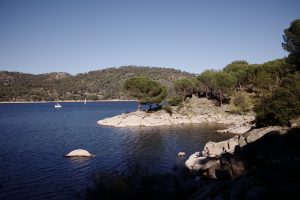
Pantano de San Juan, or the San Juan Reservoir, is located in the southwest region of the Autonomous Community of Madrid, in the municipalities of San Martin de Valde Iglesias, El Tiemblo, Cebreros and Pelayos de la Presa, southeast of the city of Avila, Spain. The reservoir is formed mainly by the Rio de Alberche (Alberche River), a tributary of the larger Tagus River, but also by the Cofio, a tributary of the Rio de Alberche.
One of the oldest reservoirs in the Madrid region of Spain, the Pantano de San Juan is supplied by a dam built in 1955. It has a total storage capacity of 138 million cubic meters, and occupies an area of roughly 650 hectares (1600 acres), spread lengthwise along a narrow valley, near the port of San Juan. At its peak, the dam has a height of 78 meters.
Although the Pantano de San Juan is used primarily as a water source for the southeast region of the Community of Madrid, one of its other functions is to divert water to the city of Toledo, Spain, through an artificial channel called the Picadas-Toledo Transfer.
Pantano de Jarosa
The Pantano de Jarosa, or Jarosa Reservoir, is located in the municipality of Madrid de Guadarrama, situated in the valley of La Jarosa. The smallest of the reservoirs in the Sierra de Madrid, it has a total capacity of 7.2 million cubic meters and occupies an area of approximately 55 hectares (136 acres).
Pantano de Jarosa was constructed in 1968, in line with economic policies of the time requiring hydroelectric power. The reservoir’s main source is the Jarosa Stream, although it also receives water from the Cerradillas. To contain these waters it was necessary to build two dams, one to cut the flow of the Jarosa Stream and another to prevent the overflow into the header source, the Cornejo Brook. In addition to supplying hydroelectric power in the region, the Pantano de Jarosa is also the sole water source for the town of Guadarrama and the neighboring municipalities of Alpedrete, El Escorial and San Lorenzo de El Escorial.
La Jarosa, as the reservoir is familiarly known throughout the area, is a popular weekend locale for both residents and tourists seeking to escape the noise and pollution of the city in favor of the peace and tranquility of the Jarosa Valley. It is also a hot spot for local fisherman, as the reservoir is regularly stocked with trout and other species, including pike and black bass, although the latter two populations are becoming harder and harder to find.
Parque Zoológico de Madrid

The city of Madrid, the capital and government seat of Spain, boasts hundreds of interesting sites and attractions to see, not the least of which is the Parque Zoológico de Madrid, or in English, the Madrid Zoo Aquarium. Located in the Casa de Campo, this 49 acre (20-hectare) park is one of the most popular recreational venues in Madrid and one of the largest zoos in Spain. The Zoo is owned by the city, but much like some other entertainment attractions in Spain, it is managed by the international entertainment operator Parques Reunidos. Parque Zoológico de Madrid is a member of the European Association of Zoos and Aquaria (EAZA) and the World Association of Zoos and Aquariums.
Parque Zoológico de Madrid was first opened in 1770 under the name Casa de Fieras. The zoo’s original location was the Parque del Buen Retiro (Retiro Park), located in the center of the city, and its purpose was to showcase animals from the American colonies—animals not native to Spain. The new facilities in Casa de Campo were constructed in 1972 and opened shortly thereafter, although at that time only the aquarium was hosted there. It was not until 1995 that the city opted to merge the zoo with the aquarium, and the animals and other zoo amenities were moved to Casa de Campo.
The Parque Zoológico de Madrid is a favorite spot for tourists and Madrileños alike, as is the Casa de Campo in general, which also hosts an amusement park and large lake. The zoo is home to over 6,000 animals of 500 different species, and is one of the few zoos in the world that houses Giant Pandas, an exhibit that thousands of people flock to each year just to get a glimpse of these rare animals. In addition to the animal exhibits, the park also has a large aquarium, with hundreds of varieties of fresh and saltwater marine life; a dolphin exhibit; an aviary; and a petting zoo, where children can get up close with a variety of animals and even have an opportunity to feed them.
Some of the most interesting animals featured at the Parque Zoológico de Madrid include:
- Giant Pandas. In 1978, China presented to the King of Spain two giant pandas: Shao Shao and Quian Quiang. A cub, named Chu-lin, was born in 1982 via artificial insemination—the first panda ever born in captivity in Europe using this method—but he died in 1996. Today the zoo is home to four giant pandas Bing Zing and Hua Zui Ba, who arrived in Madrid in September of 2007, along with their twin cubs Po and De De, born in September 2010 and conceived via artificial insemination.
- Koalas. The Koala exhibit is made possible through a temperature controlled environment, and the animals are fed Eucalyptus leaves brought from Huelva.
- Primates. Primates abound at the Parque Zoológico de Madrid, with exhibits showcasing Chimpanzees, Lemurs, Mandrills, Orangutans and Western Lowland Gorillas, among others.
The Parque Zoológico de Madrid is a wonderful place to visit, one that offers hours of family fun and entertainment. Tourists have the option of strolling through the park at their own pace or joining up with one of the many guided tours offered throughout the day, led by zoological staff members providing expert commentary and interesting facts about the animals in their care.
Madrid Safari

The Safari de Madrid is a true delight for the animal lovers in your family, and the closest thing to a genuine African or Asian safari. Without even leaving your car, you and your family will have the unique opportunity to see many different species of animals and observe how they behave in a semi-natural habitat. Much more than a zoo, the experience includes up-close sightings of lions, tigers, elephants, giraffes, rhinoceros, hippos, zebras, bison, black bears, baboons and more, all roaming free as they would in their natural environment.
Safari de Madrid first opened to the public on June 30, 1973 and quickly became one of the hottest family-fun parks in the Madrid region of Spain. It is located near the village of Aldea del Fresno, just west of Navalcarnero in the Community of Madrid, and is close to a lake and the beach-bordered Alberche River, where you can rent paddleboats and swim in the summer.
In addition to the over 500 animals roaming with semi-liberty, the Safari de Madrid also features a reptile display, with many rare snake and lizard species, and an aviary that includes several large birds of prey, including a condor exhibit and a raptor show that is held daily. The lion-taming show is another main highlight of the park, as is the petting zoo, where children can pet and feed several species of domesticated animals, including goats, sheep and chickens. The mini-zoo, a facility that recently opened on the grounds, is home to several tiger and monkey species, as well as a new installation of majestic cougars.
Your children will marvel at all the animals at the Safari de Madrid, but they will also enjoy some of the other attractions the park offers, including the Safari Karts, a go-kart track where they can test their skill driving a mock Formula One racecar, and the Mega Slide, where they can expend some of their inexhaustible energy on the six giant slides this attraction features. Also, be sure check out the restaurant while you’re there, where you’ll find cool drinks (including alcoholic drinks) and a number of snack and meal items, including burgers, tacos, hotdogs and salads.
Safari de Madrid is open daily from 10:30 AM to 5:30 PM, and the Raptor Show, one of the most interesting shows in the park, begins at 1:30 PM on weekdays and 4:00 PM on weekends.
Casa de Fieras
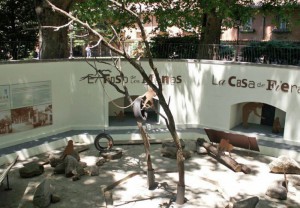
Casa de Fieras was the longest-lived name for Madrid’s first zoo, which survived for over two centuries despite not having the stability of such historic zoological institutions as the Tiergarten Schonbrunn in Vienna, Austria or the Menagerie du Jardin des Plantes in Paris, France. For a time, Madrid even had two zoos. In 1858 a small collection of animals was opened to the public as part of the botanical gardens, under the direction of the Museum of Natural Science, but that zoo lasted only eleven years, closing in 1869.
Although there is very little historical documentation regarding the Casa de Fieras, the records kept in the Royal Archives seem to indicate the zoo encountered a series of problems throughout its long history, primarily financial woes. It faced closure several times, first during the invasion of Napoleon’s army from 1808-1813. The most prosperous years of the Casa de Fieras—1884 to 1916—were when the zoo was owned privately by a man named Luis Cavanna. Cavanna was an Italian animal dealer living in Spain and a true showman; it was his idea to create circuslike animal shows for zoo visitors. A few months after his death in 1917, an inventory of the zoo’s animals showed a mere 98 specimens, including examples of Abyssinian lion, black panther, European deer, red fox, Andean condor, ostrich, peacock and pelican.
Despite having only 98 animals in 1917, the Casa de Fieras somehow survived, although it would never again thrive as it had during Cavanna’s ownership. The year 1920 saw the beginning of many major renovations aimed at modernizing the Casa de Fieras, but any progress toward that goal was ruined during the Spanish Civil War of 1936-1939, a time during which Retiro Park became a staging area for troops and a number of battles. At the conclusion of the war, records show the zoo had been reduced to only 25 animals of 13 species.
Although animals were gradually added to the zoo in the 30 years that followed the war (mostly animals from abandoned circuses around Europe), waning popularity and a lack of proper funding finally led to its end, and the animals that remained were transferred to the Casa de Campo, Madrid’s only zoo and now one of the largest in all of Spain.
Throughout the long history of the Casa de Fieras, locals and tourists alike were granted up-close access to a number of exotic animal species, the most precious being the Andean condor. Records show the large bird was added to the zoo during Cavanna’s tenure, and although there is no supporting documentation, it is widely believed the condor lived in captivity for over 60 years.
No animals have been housed in Retiro Park’s Casa de Fieras since 1972, although at times the structure has served other purposes. In the 1980s, for example, part of the facility was converted into municipal offices. Today the building stands abandoned and has sadly fallen into disrepair, but despite being empty, the history and beautiful architectural design of the former zoo makes it well worth checking out. Built in 1830, the complex was the longest-standing home of the wild animal collection and is a brilliant example of early 19th century Spanish architecture. Plans have been suggested to renovate the complex to create a state-of-the-art library in the park, but as of the writing of this article those plans are still on hold.


